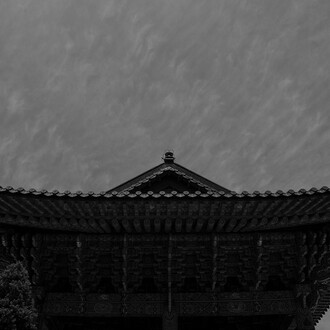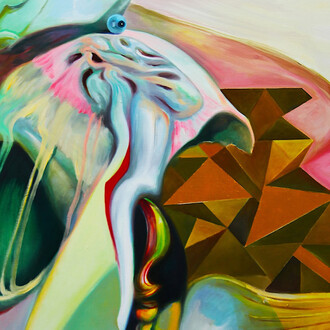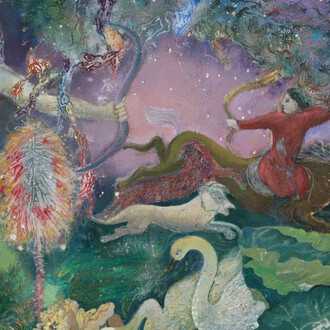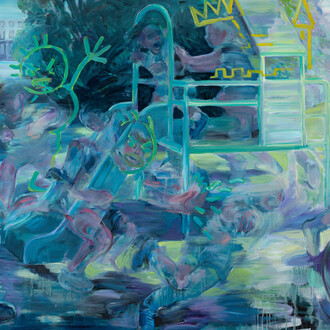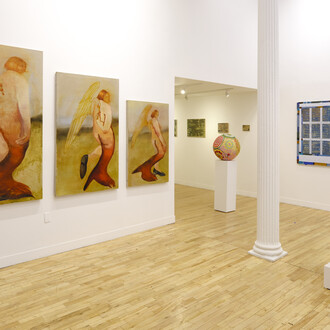Um Jae Guk’s exhibition, Ludens art, broadly draws on the theme of ludere, or “play”, as conceived of in cultural theorist Johan Huizinga’s treatise, Homo ludens: a study of the play element in culture (1938). The exhibition is something of an intermedia Gesamtkunstwerk, including Cobalt-Klein blue canvases punctuated by spilled, ribboning impasto skeins, droplet- besmirched textiles, and vari-colored ttakji toys whose thick rectangular folds are painted in motley azure, chartreuse, and speckled strokes. Creme-colored and unspooling fingerless gloves tacked on an upright panel grow threadbare as the fabric spills into a cascade below. A glowing ultramarine canvas, inspired by Yves Klein’s palette, sits, punctured by slit pocks that suggest a thrusting-piercing mechanism. Although this work in particular does not represent any perforating device, in another canvas we find such a tool impaling rust-red and flecked-white globules, beaded along the picture plane.
Each of Um Jae Guk’s works is steeped in a kind of sensorial archival history that admits of usage past, including apparently purposive tool- and garment-use rendered unusable by way of artistic predication. In turn, the objects are, as the artist themselves notes, “poetic metaphors” that home in on the notion of authorial creation vs. audience participation. In particular, the richly colored ttakji, counterposed with the static canvases, evince this dichotomy. In this manner, Guk is working in a rich tradition that includes artists like Steve Balkin, Richard Tuttle to Scott Buron, each of whom created phenomenologically attuned toy-based works during the latter half of the 20th century. In addition to such artistic precedents, Um Jae Guk’s installation- based enterprise is preceded by venerable exhibitions like Betty Parsons’ 1963-64 Toys by artists and the 1975 exhibition, Artists make toys at The Clocktower Gallery, each of which was galvanized by aspiration to collapse categorial divisions between a self-standing static work and aleatory audience participation.
Um Jae Guk is, by all accounts, a Conceptual artist and to properly understand their work, we must also take into account the subtending theoretical background of homo ludens insofar as the art object is concerned. According to Huizinga, “art language differs from ordinary speech in that it employs special terms, images, figures”. This is, in a sense, analogous to play, which, following Huizinga, transpires in a unique mode that cannot be reduced to the other routines and rote ways of being pursued by man. For play, like art—properly conceived, at the very least—which is to say, as “purposively purposive” rather than means-end directed—is motivated by “fun rather than material profit” (as Robert Anchor perspicaciously summarizes). This is precisely the context in which Um Jae Guk presents their choice art objects.
It should also be noted that Huizinga was not the first thinker to conceive of man and mankind as a sub specie ludi and to thereafter relate this to art. Drawing from Kant’s third Critique and its conception of our response to objects of aesthetic beauty, vis-a-vis reflective judgments that involve the free play of the faculty of the imagination and the understanding, Friedrich Schiller’s On the aesthetic education of man in a series of letters (1794), which introduces the notion of the “playful impulse”, presages Huizinga. For Schiller, who deeply influenced Huizinga, freedom was critical to his aesthetics theory. Contra Kant’s “Analytic of the Beautiful”, Schiller argued that freedom should not be understood as the subjective character of the aesthetic experience itself but, instead, as its content. Schiller’s letters concerning aesthetic education assert the importance for aesthetic experience for the development to human moral and political freedom. Schiller transforms Kant’s distinction between intuitions of sensibility and concepts of the understanding and reason into a distinction between drives of the inner forces that affect our conduct. Schiller claims we need to cultivate a new drive, the “play drive” (Fourteenth Letter), to bring the other two drives (viz., the form- and sense-drives), and thus to set person and condition, as well as universal and particular, into a proper balance with one another, thereby preserving “[t]he life of sense against the encroachments of freedom; and second, to secure the personality against the forces of sensation” (Thirteenth Letter).
For Schiller, as Paul Guyer recounts in his 2018 conspectus, it is the experience of beauty that induces this balance, where we are required for education to experience beauty. Because individuals tend to err in one direction, e.g. being driven by principles at the cost of ignoring principles, there are two types of beauty: “energizing” beauty and “relaxing”, or “melting”, beauty, which will “either strengthen an individual’s commitment to principles or relax the grip of principle on an individual, whichever is needed” (Guyer 2018: 486). Schiller claims that establishing such a “reciprocal relation between the two drives is indeed merely a task enjoined upon us by reason, which man is capable of solving only in the perfect consummation of his existence” (Schiller, Fourteenth Letter quoted in ibid.). Um Jae Guk’s works stage such a reciprocal relationship by positing objects that have a cultural history within an art context. This dialectical positing is also echoed by the specific kinds of objects and the intermedial manner in which they are categorized—as shimmering relics of teleological, ends-directed usage past.
(Text by Ekin Erkan)








